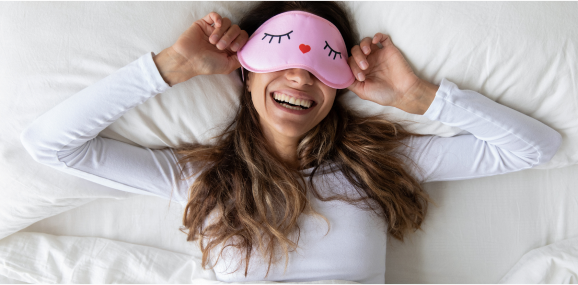When you’re stressed, tired, and simply can’t sleep, you’ll try anything to get the rest your body so desperately needs. The online marketplace is filled with options, and trying to determine which ones are research-backed and actually work can be a challenge.
The team at Hug Sleep understands. We’ve experienced our fair share of sleepless nights, too. That’s why we dove in and studied how to combat the things that stand between us and getting a good night’s sleep. We’ve looked at everything from blankets and mattresses to pillows and sleep positions in pursuit of our goal.
Weighted blankets are often a go-to option for people in need of rest. Although they’re pretty popular, some people find them uncomfortable. Here, we’ll talk about the science behind them, how they work, and whether or not another option might be better for you.
The Science of Sleep
Before we start, let’s talk about how sleep works. Although it’s a complicated process, there are three components that help your body and mind relax and help prepare you to get the rest you need. They are your circadian rhythm, your sleep drive, and your central nervous system.
It’s also important to note that the amount of sleep you get differs from person to person and by age and activity level. If you exercise heavily, for instance, your body will likely require more sleep than someone who has a more sedentary lifestyle.
Circadian Rhythm
The circadian rhythm is your body’s internal clock. Based on daylight exposure, your circadian rhythm helps your body determine day from night. This is why the average person feels rested and alert during the day and becomes sleepy and more relaxed at night.
Certain factors can affect your circadian rhythm and make it harder for you to separate day from night. Shift work and traveling across time zones can cause you to feel tired when you shouldn’t, and daylight-mimicking blue light from electronic devices can make your brain feel alert even when it’s late at night.
(Don’t believe that artificial light can affect your circadian rhythm? One study found that birds living in cities went to sleep later and rose earlier than birds in the wild because of light pollution!)
Sleep Drive
Your sleep drive works alongside your circadian rhythm to help you prepare for sleep. As you use up energy and stay awake throughout the day, your need for sleep, or “sleep drive,” builds, and you eventually become tired and ready for sleep. The process is not fully understood, but it is thought to be affected by adenosine, a chemical found in human cells.
Central Nervous System
Although the circadian rhythm and sleep drive control much of how we sleep, the central nervous system controls whether we are able to relax enough to drift off in the first place. When we aren’t able to relax, or when we’re plagued with feelings of stress, worry, and nervousness, it can feel impossible to find a way to sleep.
Stress, Worry, and Weight
Weighted blankets were created as a means of deep touch pressure therapy (DTPT), also known as deep touch pressure stimulation. Your central nervous system has two big components that regulate whether you’re in “fight or flight” or “rest and digest” mode. They are the sympathetic nervous system and the parasympathetic nervous system.
Your sympathetic nervous system, also known as the SNS, controls your fight or flight response. It keeps you alert during the day, triggers the release of hormones like cortisol to handle stressful situations, and helps you process information and respond quickly.
The SNS is important for helping you make snap decisions and execute quick judgments in situations. However, it doesn’t help you much when it’s time to relax.
That’s where the parasympathetic nervous system (PSNS) comes in. The PSNS helps calm your body and brain, triggers the release of hormones like serotonin and dopamine, and even stimulates digestion. Working alongside your circadian rhythm and sleep drive, the PSNS helps your body relax by slowing your heart rate and even relaxing your muscles.
Problems With the SNS and PSNS
Sometimes, your body doesn’t automatically switch from the SNS to the PSNS when you’re ready to sleep. This can happen for several different reasons.
- Stressful life events. If you’re stressed about work, school, problems in your community, or another major event, your SNS will be more likely to keep your mind and body on high alert, making it difficult for your PSNS to take over.
- Stimulants. Caffeine can interfere with your SNS, stimulating it and even raising your blood pressure. Additionally, caffeine has a five-hour half-life, which means that five hours after you drink a cup of coffee, half of the caffeine contents are still circulating in your bloodstream.
- Health problems. Underlying health problems, such as certain neurological disorders, can sometimes contribute to your inability to effectively switch between the SNS and the PSNS.
When the sympathetic nervous system stays turned on longer than we want it to, resting, relaxing, and sleep becomes a challenge. Fortunately, the science behind weighted blankets can help us trick the system and achieve better rest.
Hacking the System
Weighted blankets are rooted in the science of deep touch pressure therapy, also called deep touch pressure stimulation. Using gentle pressure to activate the sensory receptors on the skin, weighted blankets help stimulate the parasympathetic nervous system.
In turn, this helps your body transition out of fight or flight mode into a more restful state.
A New Twist on Existing Science
Although you might not have known about the existence of weighted blankets until you saw your favorite influencer using one, they’ve been around since 1999.
A therapist working with adults in an acute care mental health setting introduced these blankets to her patients in the hopes that the deep touch pressure would help them:
- Practice better self-care
- Encourage self-regulation
- Calm themselves in stressful situations
Since that time, the use of weighted blankets and deep touch pressure therapy have been adopted by neurodivergent patients and their medical care professionals. However, increasing research shows that DTPT can be helpful for anyone who has trouble transitioning into rest and relaxation.
What Are the Cons of Weighted Blankets?
As weighted blankets have grown in popularity, the opportunity to improve on this technology has grown, too. Early problems with weighted blankets made it necessary for retailers to issue guidelines for their use — like choosing a blanket that’s only 10% of your body weight or less.
Sleep Position
The position you sleep in makes a difference when choosing a weighted blanket. Stomach sleepers, for instance, will likely find that using a weighted blanket increases the pressure on their lower spine, which can cause low back pain throughout the day.
Even sleeping on your back or side with a weighted blanket can place an uncomfortable amount of weight on your body, making it more likely you’ll wake up with pain.
Temperature
According to sleep experts, the perfect temperature for sleeping is between 60 and 70 degrees Fahrenheit. Your body acknowledges that cooler temperatures are important for sleeping by lowering your core temperature by a few degrees before you hit the hay.
If you don’t traditionally keep your bedroom cool, adding a weighted blanket can make it too hot to sleep. Different factors, like fabric and filling, also play an important role in whether or not the blanket you choose will keep you cool enough for sleep.
Sensory Experience
Deep touch pressure therapy is similar to massage in that the same portions of your nervous system are stimulated when you use a weighted blanket. As such, it’s important that the sensory experience is comfortable for you. Much like a massage, if your weighted blanket’s pressure is either too light or too heavy, you’ll probably feel tense rather than relaxed.
Pain
Weighted blankets are sometimes suggested as a means of helping people who suffer from chronic pain — but they can ironically produce feelings of pain and discomfort themselves. While scientific studies don’t yet exist on this topic, there is plenty of anecdotal evidence from people who say they’ve experienced discomfort due to a weighted blanket.
Whether the blanket is too heavy and restrictive or causes them to sleep in a position they normally wouldn’t, the result is the same: They wake up feeling tired, achy, and sometimes in pain.
Because of these issues, a weighted blanket may not be the best option for everyone. In fact, we think there’s a better option to consider.
DTPT Without the Weight
At Hug Sleep, we were tired. And we were also tired of weighted blankets that felt suffocating. We wanted a better way to get the deep touch pressure therapy we needed… and when we couldn't find it, we created it.
Hug Sleep’s Sleep Pod
Designed to deliver the deep touch pressure stimulation you need without adding any uncomfortable extra weight, the Sleep Pod wraps you in a cocoon of comfort.
Made with lightweight, breathable fabric, the Sleep Pod provides gentle, all-over pressure that feels like a warm hug.
Our four-way stretch fabric is the secret to providing the stimulation you need — without additional weight (but with tons of breathability).
Mobility
Whether you wear the Sleep Pod alone or under a blanket, you can enjoy total freedom of movement, even for your feet. This mobility allows you to position yourself comfortably so you don’t wake up in a position that could be uncomfortable for your spine, neck, or hips.
Using the Sleep Pod is an easy, comfortable, and pain-free way of helping to stimulate your parasympathetic nervous system through the proven power of deep touch.
Lose the Weight
Just because a weighted blanket hasn’t worked for you doesn’t mean deep touch pressure therapy can’t be effective. If you’re waking up achy and in pain, it may just mean you need a different delivery method — one with a lighter, more breathable material that gently compresses your entire body for a soothing sensory experience.
Hug Sleep understands how important rest is. We built an entire company around it. Our Sleep Pod makes it easy for you to stimulate your parasympathetic nervous system, relax, and get the rest you need.
Sources:
Five Facts To Know About Circadian Rhythm | Whitney Sleep Center
The Effects of Deep Pressure Touch on Anxiety | PubMed
The Best Temperature for Sleep: Advice and Tips | Sleep Foundation
Neurological Disorders Divided by the CNS or PNS | Premier Neurology Center
What is Deep Pressure Stimulation? | Applied Behavior Analysis Edu.org

































500,000+ happy customers